SANYA, CHINA - Hainan, the South China Sea island on which this vacation city is located, is often called “China’s Hawaii.”
Like Hawaii, Hainan has volcanoes and pineapple plantations, tropical rain forests, an azure sea that washes up on coral beaches and the best golf courses (40 and counting) that money can buy. It even has the Welcome to Hawaii Hotel in downtown Sanya and the Aloha Real Estate Company.
“Hainan and Hawaii are almost on the same latitude, too (Hainan lies 20 degrees North, while the Hawaiian islands lie 21 degrees North),” points out Morgan Peng, the local guide who is showing us around China’s only “developed” tropical island which is shaped like a closed hand and juts out of the sea just south of the mainland, not far from Hong Kong.
Thanks to a series of romantic Chinese movies that used Hainan has a backdrop, the island has become a domestic tourism hotspot in recent years. About eight million permanent residents live here, but more than 30 million tourists arrive annually, most on charter holiday packages.
The likeable Morgan tells us Hainan does have one thing that sets it apart from Hawaii — the Li people, a minority group who came here from Tibet 3,500 years ago and took up residence high in the lush rain forest mountains that surround Sanya.
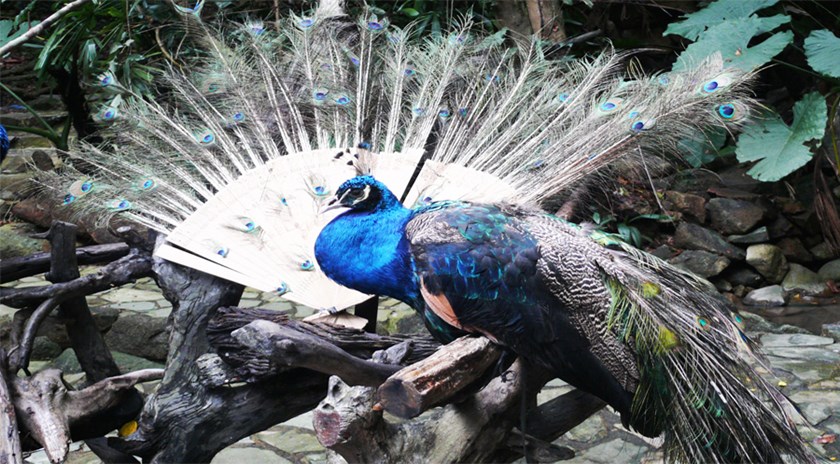
Above: Exotic birds call this tropical paradise home.
As our vehicle slowly climbs into the cloud-shrouded mountains where the main Li village is located, the young guide tells us stories about the tribe, one of three minority groups living here.
“It was once tradition for Li families to build a house in the forest for their unwed daughter (when she reached 13) so she could court potential husbands,” says Morgan. “The daughter would invite men to visit her and they sang to each other. If their singing was compatible, then the daughter would have sex with the man. If she got pregnant, a wedding would take place. It was important that the daughter be pregnant before the wedding.
“But that was a long time ago,” says Morgan, who confesses that Li family values have changed with the times.
But some primitive Li traditions remain — such as eating dog.
“The Li are very passionate about eating dog and snake,” says Morgan. “In fact, there’s still a few restaurants in Sanya owned by Li people where dog is offered on the menu — but they (dog restaurants) are getting rare these days.”
Suddenly, the dog lover in me is losing his appetite for meeting these islanders, who wash meals down with snake wine and keep boa constrictors, rare monkeys, tiny pigs and small crocodiles as family pets.
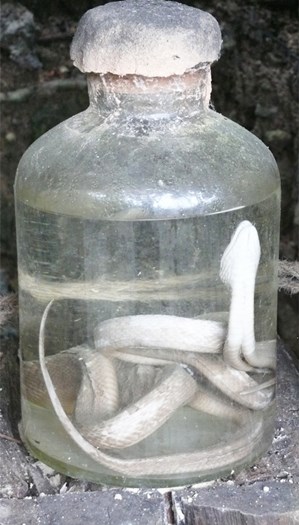
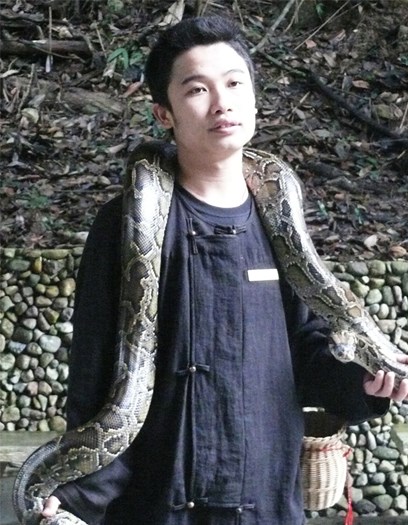
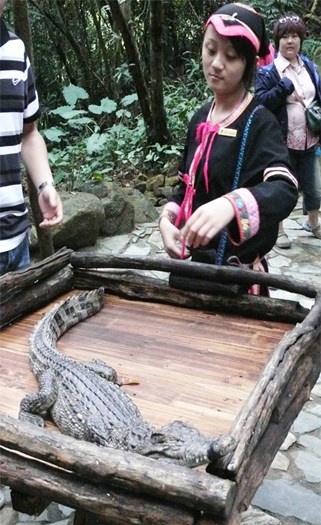
Above: Villagers like to entertain international visitors with the family "pets."
But alas, it’s too late — the tour bus comes to a stop at the entrance of the Bing Lang Gu cultural village where the cheerful Li people showcase their history, customs and incredible craftsmanship.
As I emerge from the car, a tiny puppy appears and playfully tugs at my pant leg.
“Don’t play with your food,” a wisecracker in the group says from behind.
A number of small museums scattered throughout the sprawling village recount Li history and we walk through smoke-filled huts (bad ventilation) where some Li families still live.
The oldest female members of the village bear faded tattoos on their faces, legs and arms — a painful practice that was banned when the communists seized control of China in 1949.
Li elders — some now well into their 80s — sit in front of their huts all day creating colourful garments which they sell at modern-day prices to the tourists.
The Li, who speak five different dialects, also make beautiful silver jewelry — the workmanship and detail in everything they do is truly amazing.
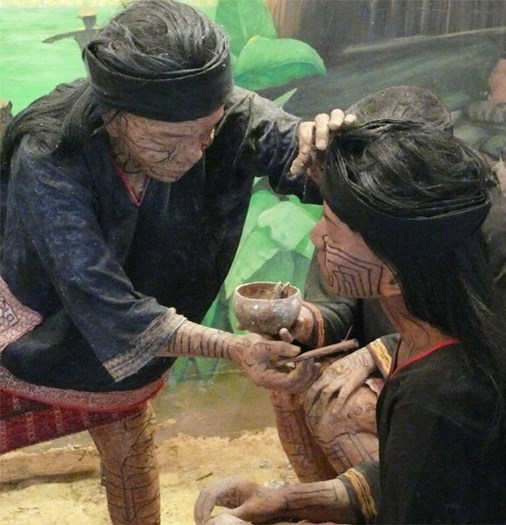
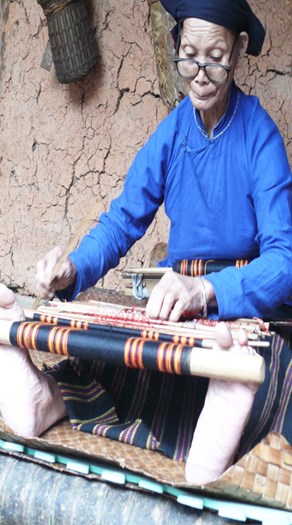
Above: The island's indigenous people put on a show for the foreigners.
Morgan says we can have something to eat in the village before heading to our next stop but before he can finish, the entire group has taken their seats on the bus. No doggie bags for this group!
Vacationers find much to do on this island, which sat undeveloped until the Chinese government designated it an “economic zone” in the 1980s and began pouring billions of dollars into Hainan’s tourism infrastructure.
Building cranes dot Sanya’s skyline — hundreds of new hotels and apartments are being built to accommodate even more tourists, but sadly the strain of over development is beginning to show on the island’s sensitive coastline.
The people of Hainan, however, do not seem to be too concerned about environmental issues, so the runaway development continues unabated.
Sanya and Haikou, the capital located on the northern tip of the island — 280 kilometres from southern Sanya — are Hainan’s two major cities.
“A high-speed train linking Sanya with Haikou was just completed and now instead of taking almost four hours by car to reach the capital, it only takes 90 minutes,” says Morgan, who moved to Sanya two years ago from Harbin, China’s most northerly city which borders Russia.
Russians also love Hainan and account for the island’s largest international tourist group — many of the signs hanging outside Sanya’s shops are written in both Russian and Chinese.
Local markets abound in Sanya but a large duty free shop in the middle of town, which caters to the Chinese consumer’s insatiable appetite for high-end European designer goods, is the favourite tourist “attraction.”
Temperatures never fall below 20C on Hainan and in the summer months, 40C days are the norm.
As we drive out of the smoky mountains where low hanging clouds obscure pointed peaks, Morgan tells us that the tallest mountains on Hainan belong to a range called the Five Fingers, which rise to 1,800 metres in height.
Another minority group which holds great status on Hainan is the Hui people — Muslims whose ancestry dates back to China’s Silk Road period and who, according to Morgan, “are the best merchants in Sanya.”
Hot springs are one of the biggest tourist draws on the island — “we have 36 hot spring locations on Hainan and each offers a different temperature of water,” says the guide.
Golf courses are springing up faster than hotels and condos and China’s nouveau riche pay upwards of $200 for a chance to play a round on courses designed by a Who’s Who list of world-renowned golf architects.
Dragon Valley, the course we play just outside Sanya during our stay, is an impressive collection of signature holes that would not look out of place in a Canadian, U.S. or Scottish resort town.
“But the best course on Hainan (and one that’s rated among the Top 10 in all of China) is the Yalong Bay Golf Club,” says Morgan, as our bus arrives in a new resort area along crescent-shaped Yalong Bay, about 20 kilometres north of Sanya.
The tranquil bay features Hainan’s longest beach — it stretches seven kilometres — but unfortunately it’s hidden from view by a collection of five-star international resorts — Ritz-Carlton, the MGM Grand from Las Vegas and many other international chains have built properties here, and more are on the way.
“Yalong Bay has the cleanest water on the island,” says Morgan. “It’s a great place to swim, snorkel and dive because it offers such great visibility.”
Seafood restaurants are abundant here and the nightlife is much better than what you find in Sanya.
It’s hard not to like Hainan Island.
Its people are warm and welcoming. Its history and traditions are intriguing. Its potential as a vacation paradise is boundless. It may not be Hawaii, but it’s a place well worth visiting on a trip to China. Just beware of what you eat.